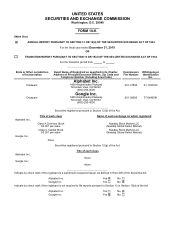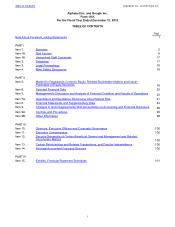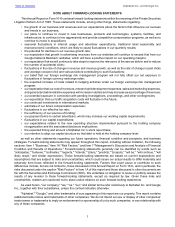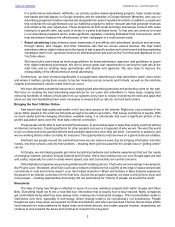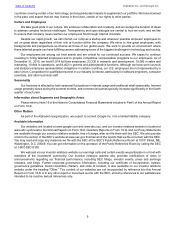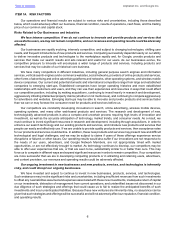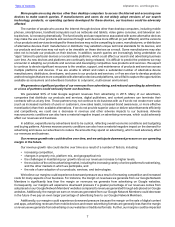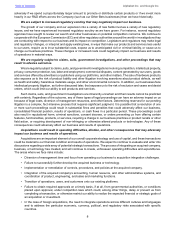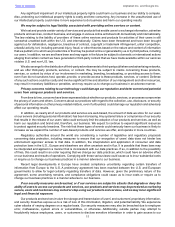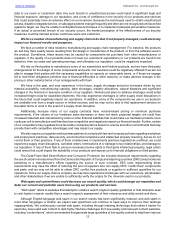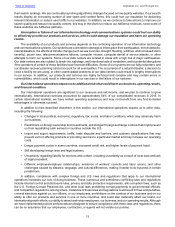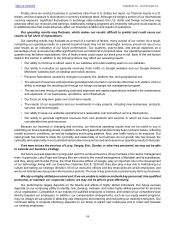Google 2015 Annual Report Download - page 11
Download and view the complete annual report
Please find page 11 of the 2015 Google annual report below. You can navigate through the pages in the report by either clicking on the pages listed below, or by using the keyword search tool below to find specific information within the annual report.
Table of Contents Alphabet Inc. and Google Inc.
7
More people are using devices other than desktop computers to access the Internet and accessing new
devices to make search queries. If manufacturers and users do not widely adopt versions of our search
technology, products, or operating systems developed for these devices, our business could be adversely
affected.
The number of people who access the Internet through devices other than desktop computers, including mobile
phones, smartphones, handheld computers such as netbooks and tablets, video game consoles, and television set-
top devices, is increasing dramatically. The functionality and user experience associated with some alternative devices
may make the use of our products and services through such devices more difficult (or just different) and the versions
of our products and services developed for these devices may not be compelling to users, manufacturers, or distributors
of alternative devices. Each manufacturer or distributor may establish unique technical standards for its devices, and
our products and services may not work or be viewable on these devices as a result. Some manufacturers may also
elect not to include our products on their devices. In addition, search queries are increasingly being undertaken via
“apps” tailored to particular devices or social media platforms, which could affect our search and advertising business
over time. As new devices and platforms are continually being released, it is difficult to predict the problems we may
encounter in adapting our products and services and developing competitive new products and services. We expect
to continue to devote significant resources to the creation, support, and maintenance of products and services across
multiple platforms and devices. If we are unable to attract and retain a substantial number of alternative device
manufacturers, distributors, developers, and users to our products and services, or if we are slow to develop products
and technologies that are more compatible with alternative devices and platforms, we will fail to capture the opportunities
available as consumers and advertisers transition to a dynamic, multi-screen environment.
We generate a significant portion of our revenues from advertising, and reduced spending by advertisers
or a loss of partners could seriously harm our business.
We generated 90% of total Google segment revenues from advertising in 2015. Many of our advertisers,
companies that distribute our products and services, digital publishers, and content partners can terminate their
contracts with us at any time. Those partners may not continue to do business with us if we do not create more value
(such as increased numbers of users or customers, new sales leads, increased brand awareness, or more effective
monetization) than their available alternatives. If we do not provide superior value or deliver advertisements efficiently
and competitively, we could see a decrease in revenue and other adverse impacts to our business. Adverse
macroeconomic conditions can also have a material negative impact on advertising revenues, which could adversely
affect our revenues and business.
In addition, expenditures by advertisers tend to be cyclical, reflecting overall economic conditions and budgeting
and buying patterns. Adverse macroeconomic conditions can also have a material negative impact on the demand for
advertising and cause our advertisers to reduce the amounts they spend on advertising, which could adversely affect
our revenues and business.
Our revenue growth rate could decline over time, and we anticipate downward pressure on our operating
margin in the future.
Our revenue growth rate could decline over time as a result of a number of factors, including:
• increasing competition,
• changes in property mix, platform mix, and geographical mix
• the challenges in maintaining our growth rate as our revenues increase to higher levels,
• the evolution of the online advertising market, including the increasing variety of online platforms for advertising,
and the other markets in which we participate, and
• the rate of user adoption of our products, services, and technologies.
We believe our margins could experience downward pressure as a result of increasing competition and increased
costs for many aspects of our business. For instance, the margin on revenues we generate from our Google Network
Members is significantly less than the margin on revenues we generate from advertising on Google websites.
Consequently, our margins will experience downward pressure if a greater percentage of our revenues comes from
ads placed on our Google Network Members' websites compared to revenues generated through ads placed on Google
websites. Additionally, the margin we earn on revenues generated from our Google Network Members could decrease
in the future if we pay an even larger percentage of advertising fees to our Google Network Members.
Additionally, our margins could experience downward pressure because the margin on the sale of digital content
and apps, advertising revenues from mobile devices and newer advertising formats are generally less than the margin
on revenues we generate from advertising on our websites or traditional formats. Further, our margins could be impacted

